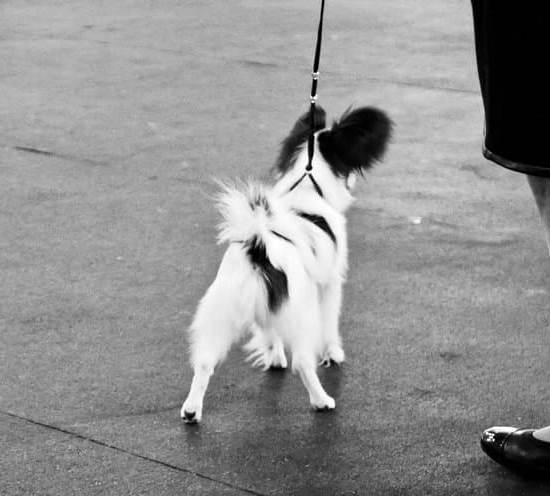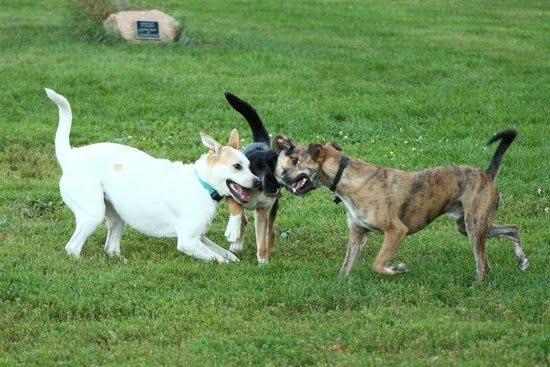Does your dog incessantly bark at other dogs during walks or at the park? If so, don’t worry – you are not alone. Many dog owners struggle with this common behavioral issue.
In this article, we will explore how to train your dog from barking at other dogs using effective positive reinforcement training methods, counter-conditioning techniques, and the importance of consistency in training. Understanding the root cause of your dog’s barking behavior is crucial in addressing and correcting this unwanted behavior.
Identifying triggers for your dog’s barking behavior is the first step in understanding why your furry friend reacts the way they do around other dogs. By recognizing what sets off their barking, you can then implement positive reinforcement training methods to modify their response and reduce their barking. From there, you can also utilize counter-conditioning techniques to redirect their attention away from the trigger and towards a more positive behavior.
It’s important to note that desensitization can also play a key role in reducing your dog’s reaction to other dogs. This process involves gradually exposing them to the trigger in a controlled manner, ultimately helping them become less reactive over time.
Consistency in training is another critical factor, as mixed signals or sporadic training efforts can lead to confusion for your pup. Through our comprehensive guide, you’ll learn how to effectively handle fear and anxiety in dogs that bark at other dogs, with real-life scenarios and practical tips aimed at making walks more enjoyable for both you and your beloved pet.
Identifying Triggers for Your Dog’s Barking Behavior
Understanding the triggers for your dog’s barking behavior is an essential step in addressing and modifying this unwanted behavior. Dogs may bark at other dogs due to fear, anxiety, excitement, territoriality, or simply as a means of communication. Identifying the specific trigger for your dog’s barking can help you develop an effective training plan to address the issue.
One common trigger for a dog’s barking behavior is fear or anxiety around other dogs. This could be due to a lack of socialization during their early developmental stages, a past negative experience with another dog, or general anxiety around unfamiliar animals. Identifying this trigger can help you tailor your training approach to build your dog’s confidence and reduce their fear response when encountering other dogs.
Another trigger for barking at other dogs could be excitement or frustration at not being able to approach them. Some dogs may bark excessively when on leash because they are unable to greet or interact with the other dog, leading to frustration and increased arousal. Understanding this trigger can help you implement training methods that focus on impulse control and calm behaviors in the presence of other dogs.
It’s important to note that each dog may have different triggers for their barking behavior, so careful observation and analysis of their reactions in various situations is crucial. By identifying these triggers, you can tailor your training methods and set realistic goals for modifying your dog’s barking behavior effectively.
| Trigger | Description |
|---|---|
| Fear/Anxiety | Lack of socialization, past negative experiences with other dogs |
| Excitement/Frustration | Inability to approach or interact with other dogs on leash |
Positive Reinforcement Training Methods for Barking
When it comes to addressing your dog’s barking at other dogs, positive reinforcement training methods can be highly effective. This training approach focuses on rewarding your dog for good behavior rather than punishing them for bad behavior. By using positive reinforcement, you can encourage your dog to exhibit the desired behavior, in this case, remaining calm and quiet when encountering other dogs.
One of the most common techniques used in positive reinforcement training is clicker training. This method involves using a clicker to mark the moment your dog performs the desired behavior, followed by a treat or reward. This creates a strong association between the behavior and the reward, making it more likely for your dog to repeat the behavior in the future.
In addition to clicker training, you can also use verbal praise, treats, toys, or affection as rewards for your dog’s calm and non-barking behavior around other dogs. It’s important to find out what motivates your dog the most and use that as a reward during training sessions. Consistency is key when practicing positive reinforcement training methods, so be sure to reward your dog every time they exhibit the desired behavior of not barking at other dogs.
| Positive Reinforcement Training Methods | Description |
|---|---|
| Clicker Training | Using a clicker to mark desired behavior followed by a treat or reward. |
| Verbal Praise | Using encouraging words and tone of voice as a form of reward. |
| Treats/Toys/Affection | Providing food treats, favorite toys, or physical affection as rewards during training sessions. |
Counter-Conditioning Techniques to Redirect Barking
If your dog exhibits barking behavior towards other dogs, counter-conditioning techniques can be effective in redirecting this behavior. Counter-conditioning involves changing your dog’s emotional response to the trigger that causes them to bark, in this case, other dogs. The goal is to replace the negative reaction with a positive one, ultimately reducing or eliminating the barking behavior.
One effective counter-conditioning technique is to use high-value treats or toys that your dog loves. When you anticipate encountering another dog during a walk, be prepared with these items. As soon as your dog notices the presence of another dog but remains calm and does not bark, immediately reward them with a treat or playtime with their favorite toy. This positive association helps them learn that seeing other dogs leads to something enjoyable, rather than something stressful.
It’s important to practice this technique consistently and gradually increase the threshold at which your dog starts barking. Over time and with repeated exposure, they may begin to associate seeing other dogs with positive experiences rather than feeling the need to bark. Patience and consistency are key when using counter-conditioning techniques to redirect your dog’s barking at other dogs.
Using Desensitization to Reduce Barking at Other Dogs
Desensitization is a training method that can help reduce barking at other dogs by gradually exposing your dog to their triggers in a controlled environment. This process involves slowly introducing your dog to the sight, sound, or presence of other dogs in a positive and controlled manner. By doing so, you can help your dog become less reactive and fearful, ultimately reducing their barking behavior.
Here are some tips for using desensitization to reduce barking at other dogs:
- Start by identifying the distance at which your dog begins to exhibit signs of barking or distress when they see other dogs.
- Once you have determined this distance, begin training at a distance where your dog is aware of the presence of other dogs but does not bark or show signs of anxiety.
- Use treats, toys, or praise to create positive associations with the presence of other dogs. For example, whenever your dog sees another dog from a distance without reacting, reward them with their favorite treat.
It’s important to be patient and consistent when using desensitization as a training method. It may take time for your dog to become more comfortable around other dogs, and it’s crucial to progress at their pace. By gradually increasing the level of exposure to other dogs while maintaining positive associations, you can help reduce your dog’s barking behavior and fear towards other dogs.
The Importance of Consistency in Training
Consistency is key when it comes to training your dog to stop barking at other dogs. In order to effectively address this behavior, it’s important to establish a consistent training routine and stick to it. Here are some key points to keep in mind:
- Set clear and consistent rules: Make sure everyone in the household is on the same page when it comes to addressing your dog’s barking behavior. Consistency in how you respond to their barking will help reinforce the training.
- Use the same commands and cues: Whether you’re using positive reinforcement or counter-conditioning techniques, be consistent in the commands and cues you use with your dog. This will help them understand what is expected of them.
- Establish a regular training schedule: Dogs thrive on routine, so set aside dedicated time each day for training exercises focused on reducing their barking at other dogs. Consistently practicing these exercises will yield better results.
Remember that consistency doesn’t just apply to the training itself, but also to how you manage your dog’s environment and interactions with other dogs. Rewriting unwanted behaviors takes time, but by staying consistent, you’ll see progress over time.
Addressing Fear and Anxiety in Dogs That Bark at Other Dogs
Understanding Fear and Anxiety in Dogs
Fear and anxiety can manifest in different ways in dogs, one of which is excessive barking at other dogs. It’s important to understand that this behavior may stem from your dog feeling threatened or overwhelmed by the presence of other dogs. This fear or anxiety can be triggered by past negative experiences, lack of socialization, or a predisposition towards being fearful. Identifying the root cause of your dog’s fear and anxiety is crucial in addressing their barking behavior.
Positive Reinforcement Training for Fearful Dogs
When dealing with fear and anxiety-related barking, positive reinforcement training methods are highly effective. By rewarding calm behavior around other dogs with treats, praise, or toys, you can help your dog associate the presence of other dogs with positive experiences. This can gradually build their confidence and reduce their tendency to bark out of fear or anxiety.
Desensitization and Counter-Conditioning Techniques
Desensitization involves gradually exposing your dog to the sight or sound of other dogs in a controlled manner, starting from a distance where they remain calm. Over time, you can incrementally decrease the distance while ensuring that your dog remains relaxed.
Counter-conditioning involves changing your dog’s emotional response to seeing other dogs by pairing it with something enjoyable, such as treats or playtime. These techniques can help reduce fear and anxiety-induced barking and replace it with positive associations.
Seeking Professional Help for Severe Barking Issues
When to Seek Professional Help
If your dog’s barking at other dogs continues to be a persistent issue despite your best efforts, it may be time to seek professional help. This is especially important if the barking is accompanied by aggressive behavior, fear, or anxiety. A professional dog trainer or behaviorist can provide expert guidance and support in addressing severe barking issues.
Working With a Certified Dog Trainer
A certified dog trainer can assess your dog’s behavior and create a customized training plan to address the underlying causes of their barking. They may utilize techniques such as desensitization, counter-conditioning, and positive reinforcement to modify your dog’s response to other dogs. Additionally, a professional trainer can offer valuable guidance on how to effectively communicate with and understand your dog’s behavior.
Consulting With a Veterinary Behaviorist
In some cases, seeking help from a veterinary behaviorist may be necessary, especially if your dog’s barking is rooted in severe anxiety or fear-related issues. A veterinary behaviorist is a licensed veterinarian who has undergone specialized training in animal behavior. They can conduct a thorough evaluation of your dog’s behavior and develop a comprehensive treatment plan that may include behavior modification techniques and medication if necessary.
By seeking professional help for severe barking issues, you can ensure that your dog receives the specialized attention and support they need to overcome their barking problem. A professional will not only work with your dog but also provide you with the knowledge and skills required to continue the training process effectively at home.
Real-Life Scenarios and Training Tips for Barking at Other Dogs
In conclusion, addressing your dog’s barking at other dogs requires patience, consistency, and a deep understanding of your pet’s behavior. By identifying triggers, using positive reinforcement training methods, and implementing counter-conditioning techniques, you can gradually reduce your dog’s barking behavior. It is important to note that seeking professional help may be necessary for severe cases of barking at other dogs, as experts can provide specialized training and behavior modification techniques.
Real-life scenarios can present great opportunities to practice training and desensitization techniques with your dog. Whether it’s during walks in the park or encounters with other dogs on the street, applying what you’ve learned through consistent training will help address your pet’s barking issues. Remember that each dog is unique, so it’s essential to tailor your approach based on your pet’s specific triggers and behaviors.
By being patient and persistent in your training efforts, you can make a positive impact on reducing your dog’s barking at other dogs. With the right combination of understanding the root cause of their behavior, using positive reinforcement methods, and seeking professional guidance when needed, you can help your furry friend become more relaxed and comfortable around other dogs.
Frequently Asked Questions
How Can I Get My Dog to Stop Barking at Other Dogs?
If you want your dog to stop barking at other dogs, the first step is to understand the underlying reason for the behavior. Dogs often bark at other dogs due to fear, overexcitement, or a desire to protect their territory.
Once you understand the root cause, you can work on desensitizing your dog to the presence of other dogs through positive reinforcement training and gradually exposing them to other dogs in controlled environments.
Should I Punish My Dog for Barking at Other Dogs?
It’s not recommended to punish your dog for barking at other dogs as this can create more anxiety and worsen their behavior. Punishment may lead to fear or aggression towards other dogs and it can also harm the bond between you and your pet.
Instead of punishment, focus on rewarding calm behavior and providing positive reinforcement when they show signs of not reacting negatively towards other dogs.
How Do I Train My Dog to Ignore Other Dogs?
Training your dog to ignore other dogs involves teaching them impulse control, focus exercises, and positive reinforcement when they remain calm around other dogs. Start by practicing in low-distraction environments and gradually progress as your dog learns to ignore other dogs.
Consistency, patience, and understanding your dog’s individual triggers are key aspects of training them to ignore other dogs effectively.

Welcome to the blog! I am a professional dog trainer and have been working with dogs for many years. In this blog, I will be discussing various topics related to dog training, including tips, tricks, and advice. I hope you find this information helpful and informative. Thanks for reading!





